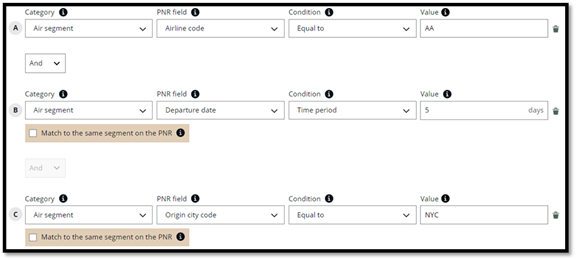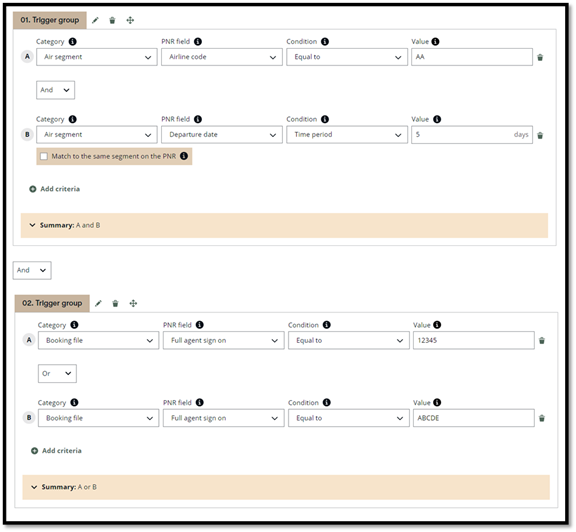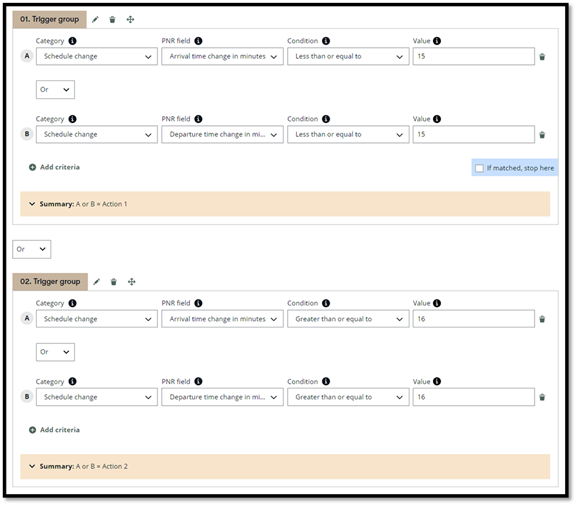Best Practices: Building a viable trigger
Introduction
Productivity Automator uses triggers to identify which PNRs to target when executing actions.
First, on the Setup page, select a target PCC (up to 25 per rule) and a target queue (up to 25 per rule). This tells Productivity Automator to look at these PCCs and queues to find the PNRs upon which you wish to execute actions.
Note: Triggers are not required. If you configure a rule without any triggers, then Productivity Automator actions every PNR in the target queue and PCC. For example, if you have a rule looking at PCC ABCD and queue 75, but you do not configure any triggers, then Productivity Automator executes the rule’s actions on every PNR that it finds on queue 75 for PCC ABCD.
After setting up your target PCC(s) and target queue(s), you can further specify the type of PNR you want to target using trigger groups and criteria lines.
Criteria lines
The basic component of a trigger is a criteria line. Criteria lines are organized within trigger groups, which are discussed in the next section. There are four elements that make up a criteria line: Category, PNR field, Condition, and Value.
Category
When building a criteria line, select an option from the Category dropdown. These are broadly grouped into segment and non-segment categories. Segment categories allow you to target elements of a particular segment (air, hotel, car, etc.). Non-segment categories allow you to target other elements of a PNR (fares, passengers, schedule changes, etc.).
PNR field
After choosing a category, you are presented with further options under the PNR field dropdown. These options differ depending on the selected category. For example, the Air segment category includes PNR fields such as Airline code and Departure date, while the Schedule change category include PNR fields that identify changes on the booking.
Condition/Value
Finally, select a Condition and Value to specify the unique criteria on which you wish to match.
In the below example, Productivity Automator looks at the PNRs on the target queue and target PCC. If any of those PNRs have an air segment with an airline code of AA, Productivity Automator executes the actions configured in the Actions page.

In this next example, Productivity Automator looks at the PNRs on the target queue and target PCC; if any of those PNRs have a departure time change that is greater than or equal to 15 minutes, Productivity Automator executes the actions configured in the Actions page.

Trigger groups
By default, the first criteria line you create is grouped under the first trigger group. If you add additional lines for more specific criteria, they are labeled alphabetically within the group, and further options become available.
Operators
Each trigger group contains one of two potential operators (AND/OR) that must be used to link your criteria lines. If you select AND, then all of the criteria lines in your group must match before Productivity Automator will execute actions. For example, if you wanted to find PNRs that included both ticketed PNRs and PNRs with an air segment with airline code AA, you would add two lines to your trigger group joined by AND, as below.
However, if you select OR as your operator, then only one of these two criteria lines needs to be satisfied for Productivity Automator to execute actions.
Match to same segment
If you are using more than one consecutive segment category on your criteria lines, you are presented with the option to match both lines against the same segment on the PNR.
In the below example, there are two criteria lines, one that is looking for an air segment with an airline code of AA and one that is looking for an air segment with a departure date within 5 days of the current date. The checkbox Match to same segment on the PNR has been checked. This tells Productivity Automator that the criteria on lines A and B must be found on the same PNR. In other words, a PNR on your target queue(s) and target PCC(s) must have at least one air segment with an airline code of AA and a departure date within 5 days.

Note: When this checkbox is present, it always “chains” back to the previous line. In the below example, a C line has been added with the same segment category as A and B.
-
If the checkbox under line B is selected, but the checkbox under line C is unselected, then A and B need to be on the same segment, but the criteria in line C could be on a separate air segment.
-
If the checkbox under line C is selected, but the checkbox under line B is unselected, then B and C need to be on the same segment, but A could be on a separate segment.
-
If both checkboxes under line B and C are checked, then all three need to match on the same segment.
-
If both checkboxes are unselected, then all three do not need to match on the same segment.

Multiple trigger groups
If you add multiple trigger groups, you will have the opportunity to create more complex trigger logic. Each group will include its own set of one or more criteria lines.
When adding subsequent trigger groups, you are also required to choose a single operator linking your trigger groups. If you select AND, then all the trigger groups must be satisfied, and all will tie to a single action.
For example below, there are two trigger groups joined by AND. The first group is looking at air segment criteria, while the second group is looking at the agent sign on to identify a particular agent associated with a PNR. Note that in the first group, AND is selected, so both lines must match, but in the second group, OR is selected, so only one must match. Both of these groups then tie to a single action.

However, if you use OR as your operator between trigger groups, then you are able to tie a different action to each trigger group. In the below example, there are two trigger groups of schedule change triggers joined by OR. The first group is looking for arrival and departure time changes of less than or equal to 15 minutes, while the second group is looking for arrival and departure time changes greater than or equal to 16 minutes. Note in the summary that each group is tied to a different action. This is useful if you wish to apply different actions to different criteria.

Note: When OR is selected as the operator between trigger groups, you will notice that another checkbox appears on the screen: If matched, stop here. If this is selected, then Productivity Automator does not proceed to the second trigger group if it finds a PNR to match the criteria in the first group.